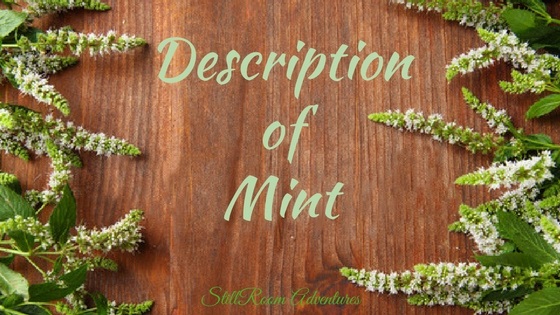Description of Mint
The information that follows is excerpted from a longer post: The Ultimate Guide to Mint. For additional information about Mint, such as cultivation, medicinal and culinary uses, or its uses through history, please click HERE to access the complete original post. Other individual sections are listed below:
 |
| Mint |
Mint is a plant from the Labiatae family. It has wide-spreading underground and over-ground stolons, which if allowed to grow unchecked can turn it into an invasive weed. Mint will attain a height, depending on the cultivar, of 1 inch to 3 feet. The smaller species make a very good ground cover and can be used in place of a lawn where conditions permit. In large, natural areas, where hardy ground cover is needed, let any of the tougher mints, such as peppermint take over. Just mow it off as it comes into flower and you will have a lush and lovely thick carpet that smells wonderful.
 |
| Mint Top Close Up |
Mint has erect, square branching stems. The leaves are arranged in pairs and are oblong to lanceolate in shape. They are occasionally downy, with a serrated margin. Leaf colors, depending on the cultivar, can range from dark green and gray-green to purple, blue and sometimes, pale yellow. The leaves are oval, pointed, and toothed. They are aromatic and deeply wrinkled due to deep veins on them.
 |
| Mint Leaf Close Up |
Mint flowers are white to purple and produced in false whorls called verticillasters. These appear on terminal spikes and have 4 stamens and a 5-toothed tubular calyx. Each flower produces four smooth ovoid nutlets or seeds. These are dark brown and small.
 |
| Mint Flowers Close Up |
I hope this helps you in identifying basic mint plants. Please leave any questions or comments in the space below!
Peace and Love Always,
 |
| Hands-on Mint! |
Sources:
Bremness, Leslie. RD Home Handbook: Herbs. Pleasantville: Reader's Digest Association, 1990. Print.
Brown, Deni. The Herb Society of America Encyclopedia of Herbs and Their Uses. New York: Dorling Kindersley, 1995. Print.
Clevely, Andi, and Katherine Richmond. The Complete Book of Herbs. New York: Smithmark, 1994. Print.
Cunnningham, Scott. Cunningham's Encyclopedia of Magical Herbs. St. Paul: Llewellyn Publications, 1992. Print.
Gips, Kathleen. Flora's Dictionary: The Victorian Language of Herbs and Flowers . Chagrin Falls: TM Publications, 1995. Print.
Kowalchik, Claire, and William H. Hylton, eds. Rodale's Illustrated Encyclopedia of Herbs . Emmaus: Rodale, 1987. Print.
Kruger, Anna. An Illustrated Guide to Herbs. Stamford: Longmeadow, 1993. Print.
Shaudys, Phyllis. The Pleasure of Herbs. Pownal: Storey Communications, 1986. Print.
Shaudys, Phyllis V. Herbal Treasures. Pownal: Storey Communications, 1990. Print.
Ware, Megan. "Mint: Health Benefits, Uses and Risks." Medical News Today. Ed. Helen Webberly. Medical News Today, 16 Feb. 2016. Web. 10 Oct. 2016.
Photo Credits:
Description of Mint Header Image: Photo Credit: Fresh mint flowers on wooden background by Africa Studio
Mint:
Photo credit: everydaygrowingcultures via Visualhunt.com / CC BY
Mint for Description Graphic 2
Photo credit: matsuyuki via Visual hunt / CC BY-SA
Mint top Close up: Photo credit: stevendepolo via VisualHunt.com / CC BY
Mint Leaf Close Up 2:
Photo credit: Matty Ring via Visualhunt.com / CC BY
Mint Flowers Close up: Photo credit: miknx via VisualHunt / CC BY-NC
Hands-on Mint: Photo Credit: hands protect mint plant grow at vegetable garden by lzf
Description of Mint Header Image: Photo Credit: Fresh mint flowers on wooden background by Africa Studio






Comments
Post a Comment